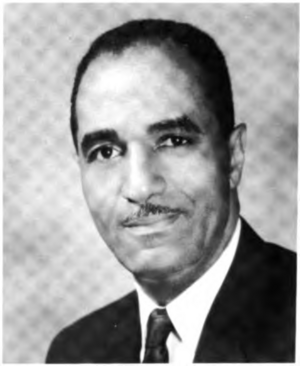William B. Bryant facts for kids
Quick facts for kids
William Benson Bryant
|
|
|---|---|
 |
|
| Senior Judge of the United States District Court for the District of Columbia | |
| In office January 31, 1982 – November 13, 2005 |
|
| Chief Judge of the United States District Court for the District of Columbia | |
| In office 1977–1981 |
|
| Preceded by | William Blakely Jones |
| Succeeded by | John Lewis Smith Jr. |
| Judge of the United States District Court for the District of Columbia | |
| In office August 11, 1965 – January 31, 1982 |
|
| Appointed by | Lyndon B. Johnson |
| Preceded by | David Andrew Pine |
| Succeeded by | Thomas F. Hogan |
| Personal details | |
| Born |
William Benson Bryant
September 18, 1911 Wetumpka, Alabama |
| Died | November 13, 2005 (aged 94) Washington, D.C. |
| Political party | Democratic |
| Education | Howard University (A.B.) Howard University School of Law (LL.B.) |
William Benson Bryant (born September 18, 1911 – died November 13, 2005) was an important judge in the United States. He served on the federal court in Washington, D.C. He was also the very first African-American Chief Judge of that court.
Contents
Early Life and Education
William Benson Bryant was born in Wetumpka, Alabama. His parents always encouraged him to study hard. He went to Howard University, which is a special college that was created for African-American students. He earned a Bachelor of Arts degree in 1932.
Bryant then went on to study law at Howard University School of Law. He graduated in 1936 with his law degree, finishing first in his class. After law school, he helped famous people like Ralph Bunche with important studies about race relations in America.
During World War II, William Bryant served as an officer in the United States Army. He was in the army from 1943 to 1947 and became a lieutenant colonel.
His Work as a Lawyer
In 1948, Bryant started working as a lawyer in Washington, D.C. He joined a law firm led by Charles Hamilton Houston, who was a very important lawyer for civil rights. At that time, it was difficult for African-American lawyers to practice law in D.C.
From 1951 to 1954, Bryant worked as an Assistant United States Attorney. This meant he was one of the first Black prosecutors in federal court in the capital city.
He returned to private law practice in 1954. He handled many important cases, often defending people in criminal trials. In 1957, he took a case called Mallory v. United States all the way to the Supreme Court of the United States. The Supreme Court decided that a person's confession could not be used if they were questioned for too long without being officially charged. This case helped protect people's rights.
While working as a lawyer, Bryant also taught law at Howard University.
Becoming a Federal Judge
President Lyndon B. Johnson chose William Bryant to become a federal judge on July 12, 1965. He was approved by the United States Senate on August 11, 1965. He then became a judge for the United States District Court for the District of Columbia.
From 1977 to 1981, Judge Bryant served as the first African-American Chief Judge of that court. This was a very important role. He continued to serve as a judge until just a few months before he passed away on November 13, 2005, in Washington, D.C.
Important Cases as a Judge
As a judge, William Bryant oversaw many significant cases:
- In 1972, he canceled the results of a union election for the United Mine Workers of America. There were claims of cheating and even a murder related to the election. Judge Bryant ordered a new, fair election.
- In 1975, he ruled that a height requirement for firefighters in Washington was unfair and illegal.
- In 1979, he found that government searches of the offices of the Church of Scientology were against the law.
- He was the first judge to order President Richard Nixon to hand over his audiotapes for civil lawsuits during the Watergate investigation.
- In a case about jail conditions, Inmates of D.C. Jail v. Jackson, he decided that the conditions in D.C. jails were so bad they violated the Eighth Amendment. This part of the Constitution protects people from "cruel and unusual punishment."
Honors and Legacy
In 2003, other judges at the U.S. District Court for the District of Columbia asked for a new part of the courthouse to be named after Judge Bryant. President George W. Bush signed this into law just two days before Judge Bryant's death in 2005. This honor recognized his long and important service to the country.
See also
- List of first minority male lawyers and judges in the United States
Images for kids
| Legal offices | ||
|---|---|---|
| Preceded by David Andrew Pine |
Judge of the United States District Court for the District of Columbia 1965–1982 |
Succeeded by Thomas F. Hogan |
| Preceded by William Blakely Jones |
Chief Judge of the United States District Court for the District of Columbia 1977–1981 |
Succeeded by John Lewis Smith Jr. |


